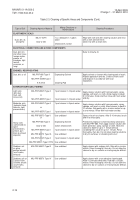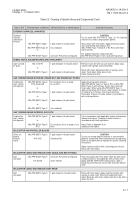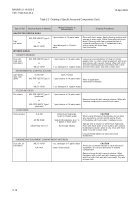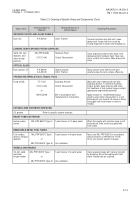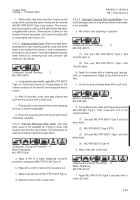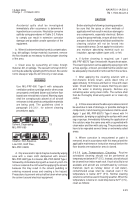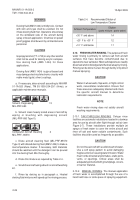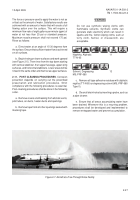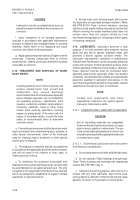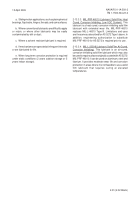TM-1-1500-344-23-2 - Page 49 of 240
2-25
NAVAIR 01-1A-509-2
TM 1-1500-344-23-2
15 April 2009
CAUTION
Accidental spills shall be investigated
immediately after occurrence to determine if
ingredients are corrosive. Neutralize corrosive
spills by using procedures in Table 2-3. Failure
to comply can result in extensive corrosion
damage and possible unsafe operation of the
equipment.
b. When it is determined that harmful contamination,
(e.g. dirt spillage, foreign material) is present, remove
the floor boards as necessary to allow proper cleaning
of the area.
c. Clean area by vacuuming all loose foreign
material, dirt, or spillage. The vacuum removal of dirt or
soil may be aided by agitating with the brush. Be careful
not to sweep or wipe the dirt into oily or wet areas.
WARNING
Use MIL-PRF-680 Type II with adequate
ventilation and be sure bilge and/or other areas
are properly ventilated (blown out) before floor
boards are reinstalled or closed. Warning signs
shall be conspicuously placed at all aircraft
entrances to indicate that combustible materials
are being used. The guidelines cited in
paragraph 2-9.3.6.1. for solvent cleaning
procedures apply.
Solvent, Degreasing
13
MIL-PRF-680
Cleaner, Non-Aqueous,
15
Low VOC, HAP Free,
MIL-PRF-32295
d. Oily areas and/or spots may be cleaned by wiping
area with a clean cloth dampened with solvent,
MIL-PRF-680 Type II or cleaner, MIL-PRF-32295 Type I,
followed by immediate drying with a clean dry cloth. Do
not over-saturate the cloth used for applying the solvent
because this may result in the solvent puddling or
entering recessed areas and creating a fire hazard.
Precautions to prevent entry shall be taken when using
the solvent around electrical equipment.
CAUTION
Before starting the following cleaning operation,
be sure that the spray or other methods of
application will not result in moisture damage to
any components, especially electrical. Before
using the spray methods, ensure all drain holes
are open, that the material will drain and that the
cleaning solution will not be forced into
inaccessible areas. Do not apply the solution to
any moisture absorbing material such as
insulation, sponge rubber (open cell), or felt.
e. If further cleaning is required, use 1 part
MIL-PRF-85570 Type II mixed with 14 parts fresh water.
The cleaning solution can be applied by spraying or with
a mop, sponge, or brush, provided that the solution can
be adequately rinsed and/or removed from the surface.
f. After applying the cleaning solution with a
non-metallic bristle brush, allow dwell time of
approximately 10 minutes and flush or rinse with clean
water. Check drain holes to assure that they are open
and the water is draining properly. Remove any
remaining water using clean cloths. The surface shall
then be thoroughly dried using warm air or clean dry
cloths.
g. In those areas where the above procedures cannot
be used due to lack of drainage, or possible damage to
components, hand cleaning procedures shall be used.
Apply 1 part MIL-PRF-85570 Type II mixed with 14
parts water, by wiping or agitating the surface with a wet
rag or sponge. Immediately following the application of
the solution, wipe the same area with a rag wetted with
clean water and then with a dry rag. The procedure may
have to be repeated several times on extremely soiled
areas.
h. Where corrosion is encountered or paint is
removed, treat in accordance with this manual and the
applicable maintenance instruction manual before the
floor boards are replaced or area is closed.
2-9.3.8. Low Temperature Cleaning. Routine
scheduled cleaning should not be performed at
temperatures below 40
°
F (5
°
C). Instead, aircraft should
be cleaned in an indoor wash rack. If such a facility is not
available and aircraft are contaminated by corrosive
materials (such as runway deicer or salt water),
contaminated areas shall be cleaned even if the
temperature is below 40
°
F (5
°
C). Normal cleaning
solutions cannot be used in freezing weather. When the
temperature is below or could drop below 32
°
F (0
°
C),
clean as follows:
Change 1 - 31 March 2010
Back to Top


